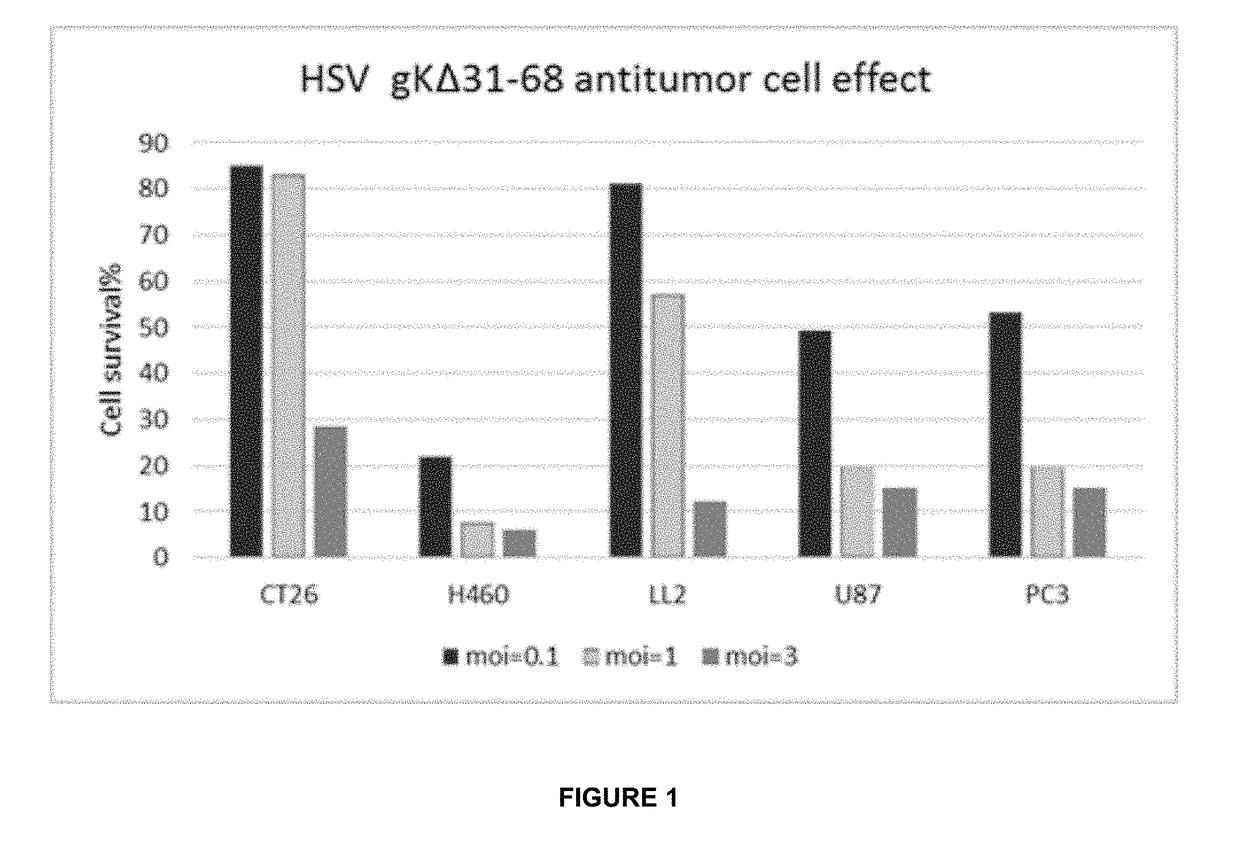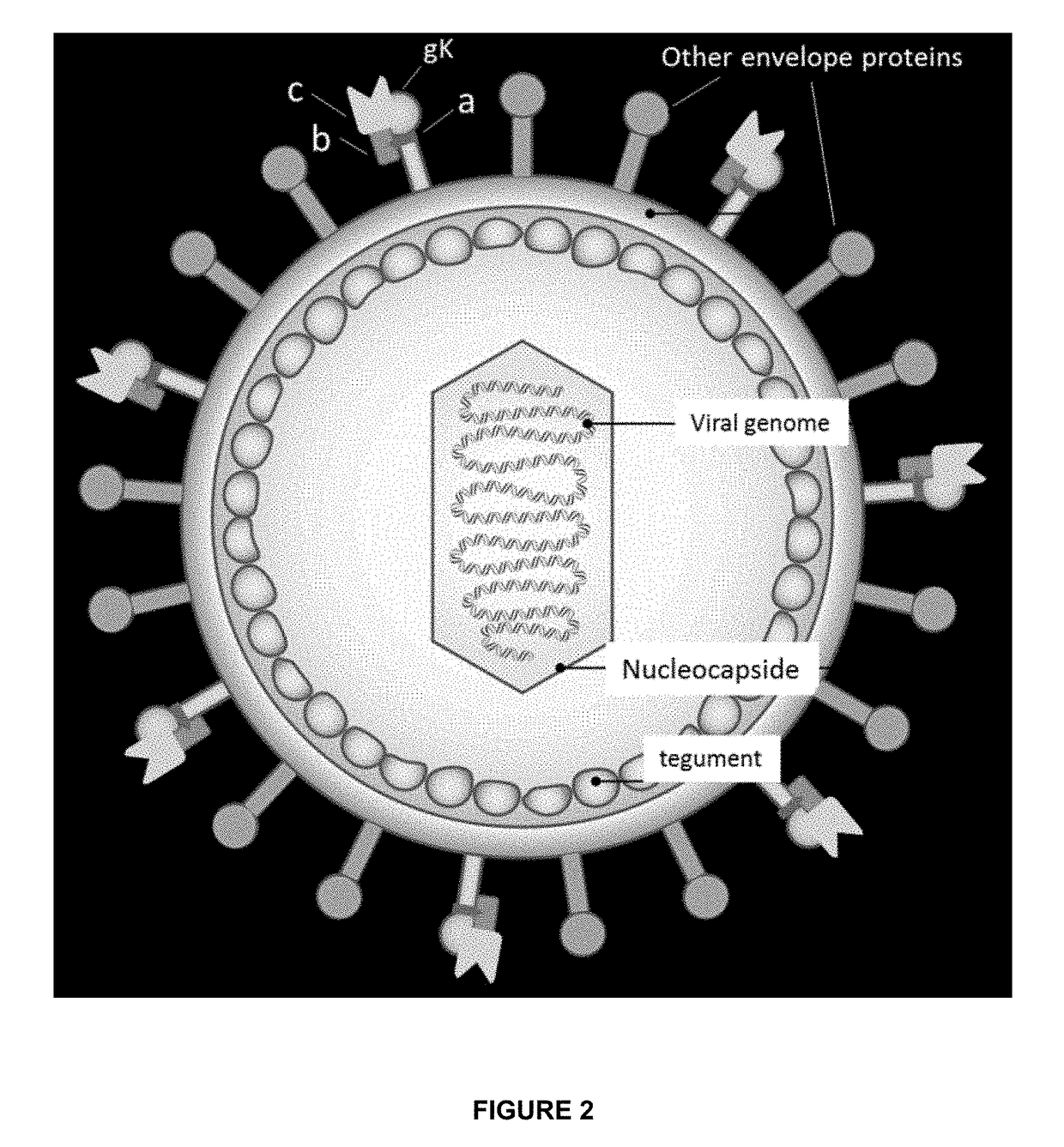Oncolytic viruses & methods of use thereof
- Summary
- Abstract
- Description
- Claims
- Application Information
AI Technical Summary
Benefits of technology
Problems solved by technology
Method used
Image
Examples
example-1
[0061]In this Example-1, various tumor cells were infected with the HSV-1 gKΔ31-68 mutant described herein for a period of 48 hours. The infected cancer cells included human colon cancer cells (CT26), human lung cancer cells (H460), mouse lung cancer cells (LL2), human glioma cells (U87), and human prostate cancer cells (PC3). Cell viability was measured and compared with control (mock infected) cells, at multiplicity of infection (MOI) points of 0.1, 1, and 3. As shown in FIG. 1, the presence of the HSV-1 gKΔ31-68 mutant exhibited a significant impact on the survival of each type of cancer cell tested and, more particularly, was able to achieve significant cell death among the cancer cells tested.
example-2
[0062]In this Example-2, multiple HSV-1 gKΔ31-68 mutants were constructed (which were subsequently tested for cytotoxic effects within various tumor cell lines, as further described in Example-4 below). FIGS. 3-6 provide maps that show the modified portions of the HSV genome in the HSV-1 gKΔ31-68 mutants. The following abbreviations, as used in FIGS. 3-13, have the meanings set forth below.
[0063]“TF-Fc” refers to a PD-L1 blocking peptide (TF) fused to an antibody Fc region.
[0064]“Au27” refers to a virus that includes a probasin promoter (ARR2PB) and a rat fibroblast growth factor (FGF) 5′ untranslated region (UTR) inserted within the intergenic region between UL53 (glycoprotein K) and UL54 (ICP27), which replaces the native promoter-regulatory region of UL54.
[0065]“ΔgK-Au27” refers to a virus that includes a modified UL54 promoter-regulatory region that is identical to the Au27 mutant and a deletion of the N-terminal amino acids 31-68 of UL53 (glycoprotein K).
[0066]“Au-M47N” refers ...
example-3
[0071]In this Example-3, expression of IL-12, IL-15, and PD-L1 blocker for the HSV-1 gKΔ31-68 mutants described in Example-2 was measured. Notably, in this Example-3, the PD-L1 blocker was specifically designed for use in human subjects, as opposed to the mouse PD-L1 blocker that was present within ΔgK-Au-mTF-Fc-IL-RA. In this Example-3, 3×104 LNCaP or UMUC3 tumor cells were seeded into each well of a 96-well plate and cultured at 37° C. overnight. The next day, seeded cells were infected with ΔgK-Au-M47N backbone, or different clones of ΔgK-Au-TF-Fc-h1215 virus (MOI=1), for 48 hours and the production of human IL-12, human IL-15 / IL-15R-alpha complex, and human IgG4 was assessed. The expression results are summarized in FIGS. 7-9.
PUM
| Property | Measurement | Unit |
|---|---|---|
| Fraction | aaaaa | aaaaa |
| Therapeutic | aaaaa | aaaaa |
Abstract
Description
Claims
Application Information
 Login to View More
Login to View More - R&D
- Intellectual Property
- Life Sciences
- Materials
- Tech Scout
- Unparalleled Data Quality
- Higher Quality Content
- 60% Fewer Hallucinations
Browse by: Latest US Patents, China's latest patents, Technical Efficacy Thesaurus, Application Domain, Technology Topic, Popular Technical Reports.
© 2025 PatSnap. All rights reserved.Legal|Privacy policy|Modern Slavery Act Transparency Statement|Sitemap|About US| Contact US: help@patsnap.com



